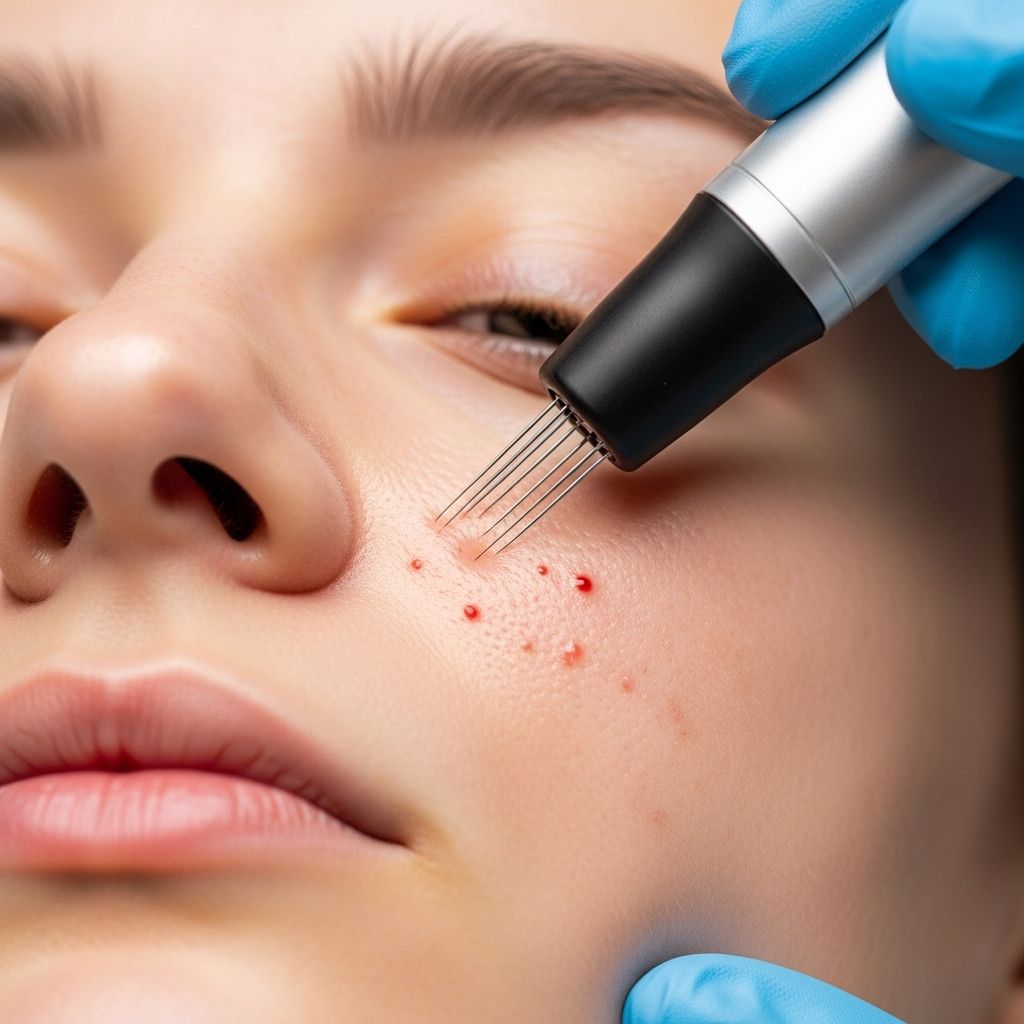Microneedling for Blackhead Scars and Skin Texture
A minimally invasive way to boost collagen and reveal smoother, more even-toned skin.

Table of Contents
- Microneedling Therapy: An Overview
- How Microneedling Works
- Benefits for Blackhead Scars
- Skin Texture Improvement
- Commonly Used Microneedling Devices
- Potential Side Effects
- Frequently Asked Questions
Microneedling Therapy: An Overview
Microneedling, also known as percutaneous collagen induction, is a minimally invasive skincare procedure that has gained popularity for its effectiveness in treating various skin concerns, including acne scars and blackheads.
This technique involves creating microscopic wounds in the skin, stimulating the body’s natural healing process, which leads to increased collagen and elastin production. The increase in these proteins helps in rejuvenating the skin, reducing the appearance of scars, and improving skin texture.
How Microneedling Works
Microneedling works by inducing controlled micro-injuries on the skin’s surface. These tiny punctures trigger the skin’s natural repair response, leading to:
- Increased Collagen Production: Collagen is crucial for maintaining skin elasticity and firmness. Microneedling stimulates collagen synthesis, which helps in filling up the depressions caused by scars and improving skin texture.
- Enhanced Elastin Production: Elastin is another protein essential for skin elasticity. While microneedling might decrease total elastin initially, it promotes the synthesis of new, more organized elastin fibers, contributing to smoother skin.
- Stimulation of Growth Factors: The process also releases growth factors that aid in skin regeneration and healing.
Benefits for Blackhead Scars
While microneedling is more commonly associated with treating acne scars, its benefits can extend to blackhead scars as well. Here’s how it can help:
- Improved Scar Appearance: By stimulating collagen production, microneedling can help reduce the visibility of blackhead scars over time.
- Minimally Invasive: Unlike surgical treatments, microneedling is a relatively low-risk procedure with minimal downtime, making it appealing for those looking for a non-invasive solution.
- Applicable to Various Skin Types: Microneedling is suitable for different skin types, including darker skin tones, with minimal risk of hyperpigmentation when compared to other treatments like laser therapy.
Skin Texture Improvement
Microneedling not only helps with scars but also significantly improves skin texture by:
- Enhancing Skin Thickness: Through increased collagen production, microneedling can enhance skin thickness, making it look more even and reducing the appearance of fine lines and wrinkles.
- Regenerating the Dermis: The stimulation of collagen and elastin helps regenerate the dermal layer, leading to smoother and more youthful-looking skin.
Commonly Used Microneedling Devices
Several devices are used for microneedling, each with its own specifications and applications:
- Dermaroller: A handheld roller with tiny needles, often used at home. It is less aggressive and suitable for gentle skin rejuvenation.
- Rejuvapen: A pen-like device used in professional settings, offering more precision and control.
- Microneedling Fractionated Radiofrequency Devices: These devices combine microneedling with radiofrequency energy to enhance heat penetration and collagen stimulation.
Potential Side Effects
Although microneedling is generally safe, patients may experience some side effects:
- Pain and Erythema: Mild pain during the procedure and erythema (redness) that resolves within a few days.
- Edema: Facial swelling that typically resolves within 24 hours.
- Post-Inflammatory Hyperpigmentation (PIH): A possibility, especially in darker skin types, though less common than with laser treatments.
Frequently Asked Questions
Q: Is Microneedling Effective for Blackhead Scars?
A: While primarily used for acne scars, microneedling can also be beneficial for blackhead scars, improving their appearance through collagen production.
Q: How Long Does It Take to See Results from Microneedling?
A: Results can be noticeable within weeks, but significant improvements may take several sessions over a few months.
Q: Are There Any Major Risks Associated with Microneedling?
A: The procedure is generally safe with minimal risks. Common side effects include temporary redness and swelling. Serious risks are rare.
Q: Can Anyone Get Microneedling?
A: Yes, microneedling is suitable for most skin types, including sensitive skin, though precautions should be taken with darker skin tones due to the risk of hyperpigmentation.
References
- https://pmc.ncbi.nlm.nih.gov/articles/PMC4509584/
- https://www.dermatologytimes.com/view/studies-support-microneedling-efficacy-acne-scarring
- https://pmc.ncbi.nlm.nih.gov/articles/PMC11499218/
- https://www.healthline.com/health/microneedling-for-acne-scars
- https://www.stratumclinics.com/microneedling-for-acne-scars-effectiveness-side-effects-and-costs/
- https://www.leadingedgedermatology.com/post/microneedling-for-acne-scar-treatment
- https://my.clevelandclinic.org/health/treatments/23113-microneedling
- https://www.miamiskinandvein.com/blog/is-microneedling-good-for-acne-scarring/
Read full bio of medha deb












